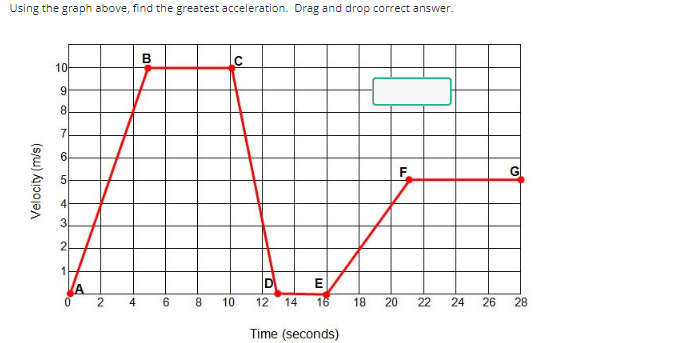Using the graph above, find the greatest acceleration.

Understand the Problem
The question is asking to determine the greatest acceleration from a velocity vs. time graph. To find the greatest acceleration, we need to identify the steepest slope on the graph, as acceleration is defined as the change in velocity over the change in time.
Answer
The greatest acceleration is $2.5 \, \text{m/s}^2$.
Answer for screen readers
The greatest acceleration is $2.5 , \text{m/s}^2$.
Steps to Solve
-
Identify Key Points on the Graph Locate the points A, B, C, D, E, F, and G on the velocity vs. time graph. These points help us determine the changes in velocity.
-
Calculate the Slope (Acceleration) Between Points Acceleration is defined as the change in velocity ($\Delta v$) divided by the change in time ($\Delta t$). We calculate the slope between each segment of the graph:
-
Between points A and B:
- $\Delta v = v_B - v_A = 10 - 0 = 10 , \text{m/s}$
- $\Delta t = t_B - t_A = 4 - 0 = 4 , \text{s}$
- Acceleration = $\frac{10 , \text{m/s}}{4 , \text{s}} = 2.5 , \text{m/s}^2$
-
Between points C and D:
- $\Delta v = v_D - v_C = 0 - 10 = -10 , \text{m/s}$
- $\Delta t = t_D - t_C = 12 - 10 = 2 , \text{s}$
- Acceleration = $\frac{-10 , \text{m/s}}{2 , \text{s}} = -5 , \text{m/s}^2$
-
Between points E and F:
- $\Delta v = v_F - v_E = 5 - 0 = 5 , \text{m/s}$
- $\Delta t = t_F - t_E = 16 - 12 = 4 , \text{s}$
- Acceleration = $\frac{5 , \text{m/s}}{4 , \text{s}} = 1.25 , \text{m/s}^2$
-
-
Find the Greatest Acceleration Compare the calculated accelerations:
- A to B: $2.5 , \text{m/s}^2$
- C to D: $-5 , \text{m/s}^2$
- E to F: $1.25 , \text{m/s}^2$
The greatest acceleration is $2.5 , \text{m/s}^2$.
The greatest acceleration is $2.5 , \text{m/s}^2$.
More Information
Acceleration represents how quickly velocity changes over time. In this scenario, the steepest slope between A and B shows the maximum rate of change of velocity, indicating the highest acceleration.
Tips
- Failing to correctly identify the slopes between all segments on the graph.
- Confusing acceleration with deceleration; negative acceleration can sometimes be overlooked.
- Not considering all segments when comparing accelerations for the greatest value.
AI-generated content may contain errors. Please verify critical information